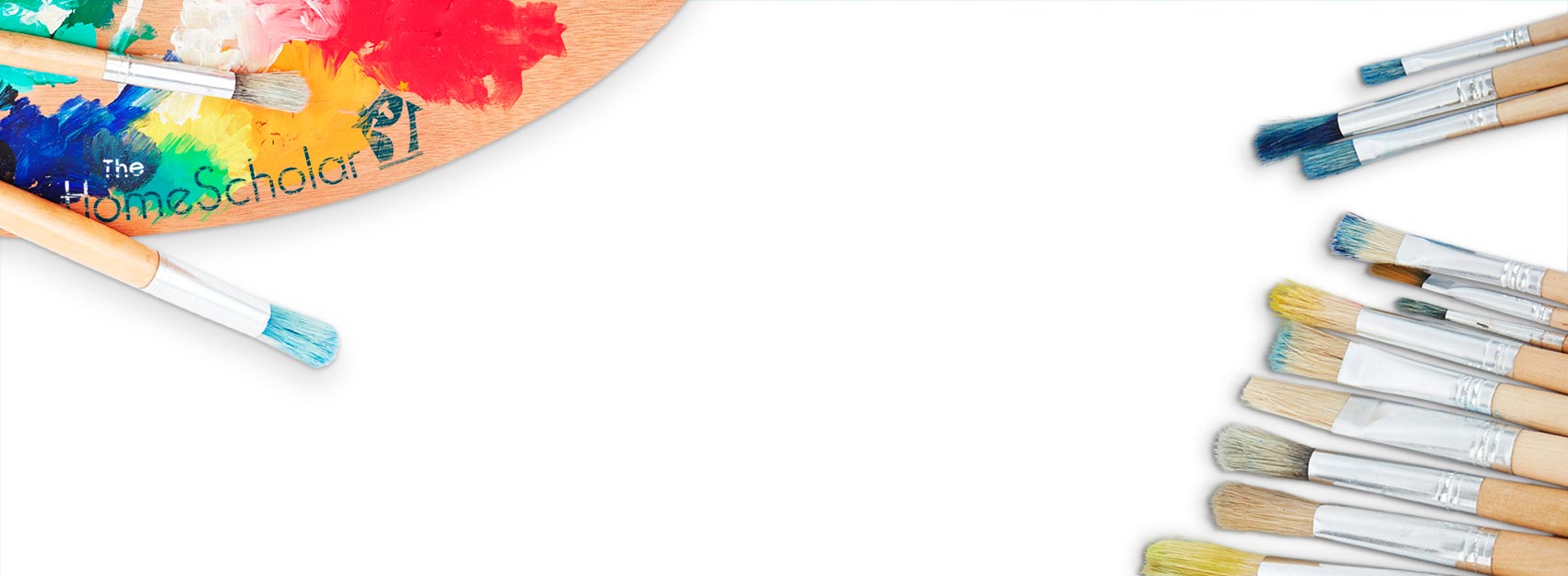
Homeschool Art Klutz Disclaimer
My relationship with homeschool art is kind of twisted, really.
I love science, but I really don’t like art! As a nurse, I have a science and math background. Those are my favorite subjects! When we did microscope work, I would find myself going back again and again to look through the microscope by myself!
But art…That was a completely different story.
Art was a weak area in my homeschool. It was one subject that we all had to work at, or it wouldn’t get done. If we didn’t set aside time for homeschool art study it would never happen! It may sound strange to some, but we never had that problem getting math or science done. Just art. You could say that instead of art being a “delight directed” subject, it was simply a “directed” subject.
But I was determined to provide a well-rounded education, even if it meant including this most obnoxious subject. I carefully scheduled art a few times a week for two hours at a time. I figured that should be just often enough, and provide enough time to get something done. Even so, it sometimes didn’t happen.
The Obvious Problem - Homeschool Art is Messy
I’m tidy by nature, and homeschool art is messy by nature. It would be different if it took place in a studio somewhere, but homeschool art typically occurs at home. You know... where we live. We were a mismatch from the beginning. Homeschool art could get my house covered in so many crazy colors. Homeschool art makes a mess. Homeschool art caused stress because my kids just didn’t “get it.” And homeschool art takes so many materials! You have to buy so much stuff just to paint one thing! The problem for my kids wasn’t so much the mess. They had NO problem with the mess. It was just that every minute spent on art was one less minute doing what they loved; namely, math, science, chess and economics.
We all have weaknesses.
I know for certain that art is my nemesis. I tell parents that when you identify your weak area, that’s what you do FIRST. It’s the first thing you spend money on when you buy curriculum. It’s the first thing you consider purchasing again when necessary, if your first choice doesn’t work. It’s the first thing you do each day. It’s the first thing you get done before going out to a fun event

Finding the Artistic Spark to Learn Homeschool Art
I never really sparked a love of art. My boys were simply not interested. I thought I had it all figured out when we tried pottery. After all, wouldn’t boys just love playing in the mud? But no, pottery was also merely tolerated. At least the mess (I mean “fun”) wasn’t in my house, but still the art idea didn’t take. I tried teaching art with games: The Impressionists Art Game and the Parker Brothers game called Masterpiece. They enjoyed playing it because they love to compete against each other, but I’m not sure a purist would call that “art.”
Teaching Homeschool Art in High School
I knew I would really have to force myself to teach art. Others may be able to provide art “experiences” but as a true art klutz, I didn’t know how to do that. For me and my homeschool, I needed curriculum to help me teach that dreaded subject. When the children were younger, we used the book “Art Fun” the first year. My children were much more interested in reading the books than actually doing the projects. Slightly older, I used the curriculum “Feed My Sheep.” In high school we used “Draw Today.”

Fine Arts Defined
One year I realized that colleges wanted to see one year of Fine Arts on a high school transcript. As an art klutz, I had to go to the dictionary and look up “fine arts” to see what they meant. The Fine Arts are music, art, theater, and dance. You don’t have to do it all, and you don’t have to do it every year.
My children don’t enjoy drawing, but they tolerate music. One year I purchased a 10-CD pack of great composers. Each CD was a different composer. My idea was to have a “composer of the week.” We would just play a CD during lunch and maybe during math. I found portraits of the great composers on the web, that I would print. We read about them, sometimes online and sometimes from library books. In high school we studied music appreciation with “How to Listen to and Understand Great Music” by The Teaching Company. It was our favorite lecture series. The teacher has a wonderful vocabulary, and my boys would take college level lecture notes in real time, while listening to the wonderful music content.
Creating Art vs. Studying Art
If your kids just “do” art, then maybe you don’t really need to “study” it. We needed to make art a subject, because my kids would never do it otherwise. We used books and curriculum for art history, perspective, and art appreciation. If you aren’t a modern day Michelangelo, don’t despair. You can give your children a perfectly acceptable appreciation for the arts. You don’t need to destroy your home or convert the hallway into the Sistine Chapel. The key is to be flexible and willing to see “Art” in creative (dare I say artistic?) ways. You can still emerge at the other side with balanced students who will appreciate (if not necessarily create) fine art.
I guess it worked. Fine Arts was my “great failing” in homeschool high school. I tried to expose my kids to art during high school but, honestly, it was a pretty pathetic effort. Fast forward two years. According to Facebook, here is what my son did one weekend at college:
Alex loved “The Marriage of Figaro” yesterday, went to the Seattle Art Museum today, and is going to “Rhapsody in Blue” at the Seattle Symphony tonight. The pattern is starting to damage my street cred.
Apparently it was successful. I’m amazed that someone like me, who is “artistically declined”, can raise someone who enjoys the arts so much!
Art klutz parents of the world, unite!

Art Lovers ... Start Here!
Now I want to speak to the other end of the spectrum, the Fine Arts Aficionado. You know who you are. Some parents and kids just LOVE the arts, and get SO passionate about it that they end up with multiple credits of fine arts every year of high school. You know, that’s GREAT! It shows the unique aspects of your child, their passions, interests, pursuits. Colleges just love passion! The problem, of course, is getting the rest of the stuff done!It can seem almost impossible to achieve the balance between providing children the subjects they love and making sure they also get the subjects the need. One mom confessed, “I feel as though I am running a performing arts school. My daughters cannot get enough of the arts: acting, dancing, art, voice, music, creative writing, UGH! I am worried about trying to squeeze in all the important and required subjects for their high school transcripts in between all the arts. Academics are important to me and my daughters are very capable, bright and focused, but they just seem so passionate about the arts. I would hate to have them give up their time on these subjects. On the flip side, I don’t want to skimp on their academics and limit their choices for colleges and scholarships. I would like to know what is required for a performing arts school, and what that looks like on a high school transcript.”Here are some tips for fitting it all into your 24-hour day. These will help you grab high school credit when you can, and enjoy the ride along the way!
Cover Core and Capture Delight
You want to both cover the core classes and capture delight directed learning. Be sure to cover the core classes of reading, writing, math, science, and social studies. Within those core classes, try to teach them in an interesting way that makes it more meaningful for your child. It’s possible to teach some core subjects with delight-directed classes, but make sure you cover the core one way or another. Once the core is covered, try to capture the delights of your child, and translate them into courses on your transcript. You don’t have to plan, or direct, or evaluate with tests or quizzes. Just capture the learning.

Big Rocks First
Once those core subjects have been done, it’s amazingly easy to add everything else your children will love doing, and chances are they will have plenty of time. If each academic subject takes 1 hour, then core classes may only take 4 hours per day.
Put in the most important things first, and you’ll have more time for fun. Academically, that means English, math, science, social studies. Once those core subjects have been done, it’s amazingly easy to add everything else your children will love doing, and chances are they will have plenty of time. If each academic subject takes 4 hours, then core classes may only take 4 hours per day. A child that loves the arts will be able to spend the rest of their free time doing everything they want with their music and performance. Sure they will be busy - anybody who is passionate about what they do will always wish for more hours in the day! But they will be able to get it done if they put in the big rocks of heavy academic subjects first. I know a young man who got up early in the morning to finish his academics before 9:00 am, so he could pursue his interests all day long. For encouragement, read the story of The Mayonnaise Jar and 2 Cups of Coffee.
Identify Strengths and Weaknesses
It’s good to be up-front about what your child is good at, and where they need encouragement. Art and Theater people are excellent in accruing fine art credits. They can often get some PE credits if they are involved in dance or marching band. They are often the kind of child who does well with English and foreign language classes. However, they don’t often tend to like math and science. So look at your child, and see what they like to do. Then look at the subject they avoid, or complain about. Even if they are successful in those subjects, and get A’s in class, you might still consider it their weak areas. That will help you take action, so you can make school smoother, more pleasant, and more effective in the long run.

Weak Areas First
Your weak area is the first thing you do with your time. It’s the first thing your student does in the morning. It’s the one thing you make sure is done every single day. Even when a fabulous opportunity arrives, and all the other homeschool things get put on the shelf, this is the one thing you are sure gets done. You always take the time for it even when there is a field trip, activity, or 8-hour theater rehearsal that day. And your weak area is the first thing you do with your money. It’s the first curriculum that you buy each year, and the thing you are willing to spend the most money on. It’s the only thing you will be SURE to reinvest in if necessary. In other words, if you choose a curriculum and it doesn’t work, this is the area that you will make a second purchase – even within the first couple of months of school.
Honest and True Transcripts
When you are music and theater people, it can help to think about what would happen if your child was doing music and theater in a public school. Each class would be on their high school transcript, even though there is more than one fine art per year. The public school child might have Theater 1 credit, Band 1 credit, Choir 1 credit, and Orchestra 1 credit. That would be 4 credits per year. For homeschoolers, we can divide those musical/theater experiences into groups that we call ‘classes.’ Put each one as one credit. Another way of looking at it: if your children do theater every year, and it’s over 150 hours, then give them 1 credit of theater. If they also do the violin for 150 hours or more, then give them 1 credit for violin. If they ALSO do piano, and they do more than 150 hours of piano (not counting time they spend on violin), then you can give them 1 credit of piano.

Have a Morning Meeting
Having a morning meeting can help. If you check in with your child each day, you can shape and mold their ‘responsibility index.’ A quick 15 or 30-minute check-in for core subjects each day can help you assess the situation and keep kids on task. It will help them so they do not ‘forget’ school for a week and suddenly fall hopelessly behind. A daily meeting is a great goal. In practice, of course, a day will be missed here and there. We are all busy people with busy lives, after all! But if you forget a day or two, you will still benefit. If you miss a few days, you can regroup and discover any missed assignments. If you tend to fall behind, or if you see your student overwhelmed by an insurmountable mountain of work, instituting a ‘Morning Meeting’ can be the perfect answer.
Performing and Visual Arts Colleges
If your child is interested in music, art, theater, or dance, finding a college can be stressful. College admission requirements at performing arts schools vary greatly, so you need to check with each school to see their requirements. Some want to see heavy academics, and even advanced math, because students won’t get a lot of math or science once they are on campus. Other performing arts schools only require a general education, and their admission is based mostly on an art portfolio or performance audition. It really depends on what kind of degree a student wants, and what kind of college the student chooses to attend. To find requirements, looks for colleges that participate in Performing & Visual Arts College Fairs. You can find lots of information for fine arts possibilities on the NACAC website at www.nacacnet.org.

Help Artists Be Prepared
There are some specific and concrete steps that may help artistically inspired students become prepared for any college or career. Complete the heavy academics in the morning, before lessons. English, math, science, and social studies might be best in the morning. Excessive car time is common with children that have multiple musical instructors and numerous performing events. Make use of car-schooling techniques by getting audio classes to enjoy. For example, look at history CDs like Ancient Civilizations: A Biblical World History Curriculum by Diana Waring. If that isn’t a good fit, consider The Great Courses, like The Foundations of Western Civilization.Some children are able to read in the car, or speak and listen to foreign language lessons in the car. Others are adept at using their computer or iPad for video lessons during long drives. Car schooling can be successful, but don’t forget to also teach your young adults to drive, and give them time to practice that skill as well.
Yes, your child loves fine arts! And that is awesome! You can emphasize strengths, shore up weaknesses, and provide a strong and well-prepared academic record. Including your child’s area of specialization can present them in the best possible light. Don’t shy away from subjects that inspire delight! Just be sure to provide a balance of preparation, so your child has unlimited possibilities.



